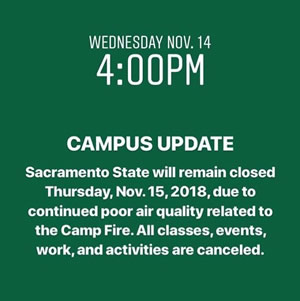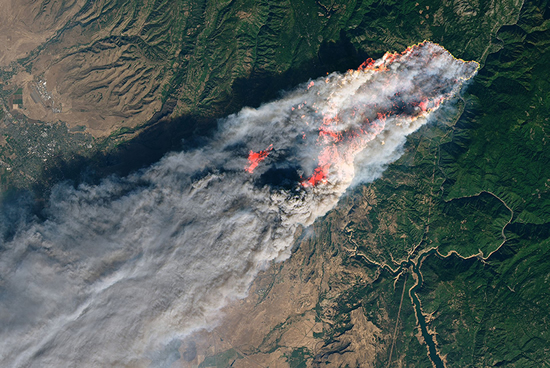BEHIND THE SCENES

ABA Staff Working Despite Campus Closure
From November 8th through November 25th, the Camp Fire ravaged Butte County, destroying over 18,000 structures, causing 85 fatalities, and spanning over 150,000 acres. The deadliest and most destructive fire in California's history caused a nearly unfathomable amount of damage.
While Sacramento residents were not directly affected by the flames of the fire, the smoke impacted nearly all of northern California. John Balmes, physician at the University of California, Berkeley, who sits on the California Air Resources Board, noted that the smoke from the fire "resulted in the worst air pollution ever for the Bay Area and northern California."
While fire stations began distributing N95-rated masks to help filter out airborne particles, residents were advised to stay indoors and to limit exposure to the smoke. On Monday, November 12th, by order of President Nelsen, Sacramento State announced it would be closed the next day, Tuesday, November 13th. The campus had not closed due to a weather related event since the floods of 1986.
 The campus remained closed throughout the week, while faculty, staff, and students were notified by email, text, and by phone of the closures. These sudden announcements were made possible by Sacramento State's Emergency Notification System (ENS). Sacramento State Police Department's Chief Iwasa worked closely with the Office of the President to issue notifications of the campus closure.
The campus remained closed throughout the week, while faculty, staff, and students were notified by email, text, and by phone of the closures. These sudden announcements were made possible by Sacramento State's Emergency Notification System (ENS). Sacramento State Police Department's Chief Iwasa worked closely with the Office of the President to issue notifications of the campus closure.
Despite the general campus closure, "essential staff" were required to return to work to perform essential duties on campus. Many of these staff were ABA staff professionals from Risk Management Services, Facilities Management, and the Police Department, and other offices and divisions. This edition of the Behind the Scenes will focus on the efforts ABA staff professionals made during the closure.
Due to the smoke, air quality was of top concern. For days, Sacramento was experiencing elevated levels of PM 2.5. PM 2.5 is short for "particulate matter" that is 2.5 microns in size. For reference, a human hair is about 100 microns. PM 2.5 particles are known to reduce visibility and cause the air to appear hazy. During the campus closure, the Sacramento region was experiencing a rating of PM 2.5 particles in excess of 400 at times, and sustaining over 200, according to the airnow.gov Air Quality Index (AQI) rating. An AQI over 150 is considered unhealthy, while an AQI over 200 is very healthy and over 300 is considered hazardous.
Tyler Harris, an industrial hygienist from the office of Environmental Health & Safety (EHS) was monitoring air quality on campus. "As the campus Industrial Hygienist, I monitored and evaluated the indoor and outdoor air quality of the campus," said Harris. "For indoor air quality, my primary task was to evaluate the spaces in which essential employees would be working, and provided recommendations to campus administrators as to how to help mitigate spaces which may have had elevated levels of particulate."
The work of Harris and his colleagues was essential to ensuring Sacramento State employees were safe while on campus. Harris expressed his concerns when he realized how little was known about air quality by the general  public. "My major concern in relation to the overall air quality was the lack of knowledge as to how serious of an issue that respiration of these particulates are to the body. It is all about the dose, with even short term exposures having the ability to cause long term health effects," stressed Harris.
public. "My major concern in relation to the overall air quality was the lack of knowledge as to how serious of an issue that respiration of these particulates are to the body. It is all about the dose, with even short term exposures having the ability to cause long term health effects," stressed Harris.
President Nelsen made note of the cooperation between his office and the office of EHS during the campus closure: "The Office for Environmental Health & Safety will continue to monitor the air quality tonight and throughout the duration of the fire, and will advise if the campus should be closed." The work of staff from EHS, and that recommendation, continued until the campus reopened on Friday, November 23rd.
While EHS ensured essential staff had safe workspaces, work continued in other areas of the campus. In Financial Services, limited staff from Accounting Services, Accounts Payable & Travel, Procurement & Contracts, the Bursar's Office, Hornet Ticket Office, Central Receiving, and Financial Services Administration were on campus or worked from home to ensure important financial work was completed.
According to Associate Vice President of Financial Services, Gina Curry, staff performed the necessary financial duties of the University. "We had some important deposits from donors, emergency grant checks, financial aid disbursement and November 15th payroll disbursement," explained Curry. "I came in several times to support my managers. I was also working remotely to oversee approvals for disbursement and coordinating emergency checks." Much credit is deserved to the staff of Financial Services who made sure the University met its financial obligations. "I just want to give kudos to my team for their unquestioning willingness to do what needed to be done during this unprecedented closure," concluded Curry.
ABA's largest division, Facilities Management, still maintained a workforce to perform essential functions as well. Staff and managers representing  University Housing, Custodial Services, Operations, Grounds, and Engineering Services were on hand to support the remaining campus workforce. So long as other offices on campus were open, staff from Facilities Management were needed to help maintain walkways and workspaces, including room temperature, cleanliness, and other support services.
University Housing, Custodial Services, Operations, Grounds, and Engineering Services were on hand to support the remaining campus workforce. So long as other offices on campus were open, staff from Facilities Management were needed to help maintain walkways and workspaces, including room temperature, cleanliness, and other support services.
"The fires had a huge impact on our operations and raised many questions on how to provide as clean as air possible in the buildings in order to keep the students, faculty and staff safe," explained Tim Bair, manager of engineering services. "We also had to maintain operations in buildings that had essential staff working and filter the air as much as possible by controlling the amount of outside air being pulled into the buildings from the HVAC system," said Bair. Staff from engineering services provide the campus with 24/7 boiler operations for call campus heating and cooling needs. "We had to keep the plant online for heating of the buildings and to make sure if campus were to open back up heat would be provided," concluded Bair.
Finally, Sacramento State's Police Department remained on duty to ensure the safety and security of all employees and visitors. "All sworn personnel in the patrol, communications, and investigative departments reported to duty to provide a continuous police presence on campus thorough the campus closure," said Lieutenant Wu. "During the closure, there was no disruption of service in the areas of safeguarding the campus, pro-active patrol, alarm monitoring, and investigative follow-ups." In addition to regular patrols and extra safeguarding measures imposed on campus, the Police Department secured 25,000 N95 masks for the campus employees and students. All employees were provided the option of wearing the protective mask and patrol personnel were required to have a supply of the masks available for distribution.
Despite the nearly state-wide effects of the camp fire, Sacramento State, with the direct support from ABA ensured the campus remained a safe environment for all faculty, staff, students, and visitors. If you would like to make a monetary or time donation to victims of the Camp Fire, Sacramento's local CBS affiliate CBS13 has compiled a list of multiple organizations receiving donations: https://sacramento.cbslocal.com/help-2/



